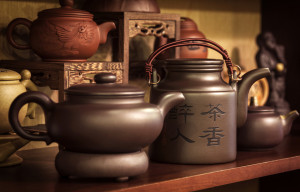Using the art of tea to create an atmosphere of tranquility and peace.
Tea in Chinese culture is to Wine in Western culture. It is loved for its subtle colors, aromas, and tastes. The origin of Tea as a beverage is one of legend, for the story goes that it was discovered by Shen Nong, a legendry emperor and father of Chinese medicine who lived over 5000 years ago. Shen Nong created a fire under a tree to boil some water, for he was parched and tired from searching for herbs. As the water boiled, leaves fell into the pot. Shen Nong was allured by the aroma, and curious about the taste, so he drank it. Immediately he felt refreshed, as if all of his exhaustion had left his body. This made tea an herb used in medicine, however; it grew in great popularity in the courts of emperors, for people who could not stomach wine were given tea, and it eventually became the beverage of choice by the Sung Dynasty (A.D. 960).
The method used to cultivate tea was developed during the Han Dynasty (206 B.C.), and is still in use today. During this period, the Chinese did extensive research on tea. They studied where and how it grew, which soil, climate, and leaves were the best. They also studied when to pick and how to treat the leaves. From different regions, came different styles of brewing, serving, drinking.
One of the most famous characters in the history of tea is Lo Yu. He devoted his life to tea, and wrote the Classic of tea, which was the 1st authorative book on tea. It was written in A.D. 780, and was translated into many languages and distributed by trade. He investigated not only the tea, but the water, fire, and teapot. He is recognized as the Sage of Tea.
There are 6 subdivisions of tea: White, Yellow, Light Green, Green, Red, and Black. Most Westerners are familiar with and drink red and black teas. All teas flavor are based on region, climate, soil, sunlight, and water. Much like how every fall is different; a green tea from the south will be different from a green tea in the north. Also the time the leaf is picked, and in what season it was picked will make a difference as well. There are actual schools where you can learn everything about tea, including the cha dao for each type of tea.
The health benefits of tea depend on the type of tea itself, and also the quality of the tea. Green tea is the most known of all the teas in China, Oolong tea will have very similar health benefits. Its health benefits include: its rich in polyphenols like flavonoids and catechins, which function as powerful antioxidants. Antioxidants can reduce the formation of free radicals, which play a role in inflammation, aging, and diseases in the body. They also protect cells and molecules from damage. Studies have also shown that catechins can kill bacteria and inhibit viruses like the influenza virus, potentially lowering your risk of infections. Catechins also can improve your dental health by killing bacteria that causes tooth decay.
Green tea also contains L-theanine, which increases the activity of the inhibitory neurotransmitter GABA, which has anti-anxiety effects. It also increases dopamine and the production of alpha waves in the brain. Studies show that caffeine and L-theanine can have synergistic effects. The combination of the two is particularly potent at improving brain function.
Green tea has been shown to boost the metabolic rate and increase fat burning in the short term, reduce insulin sensitivity and reduce blood sugar levels. It also has been shown to lower total and LDL cholesterol, as well as protect the LDL particles from oxidation.
Oolong tea, more specifically Tie Guan Yin, provides Potassium, Calcium, Zinc, Magnesium, Iron, Manganese, Phosphorus, Fluorine and Vitamin C. It has been known to prevent cancer, diabetes, and osteoporosis. It also removes body toxins. It slows the cellular aging process, improves metabolism, relieves stress, and promotes energy. Oolong tea improves digestion, protects the body from cardiovascular atherosclerosis, reduces body fat, and improves gallbladder function. Like all Chinese teas, Oolong is brimming with antioxidants.
Puerh tea has been shown to lower cholesterol, treat metabolic syndrome by improving obesity, beneficially adjusting blood lipids, lowering blood sugar and preventing oxidation of cholesterol plaque. Researchers recently discovered that puerh tea inhibited tumor growth through a variety of mechanisms, and has a similar amount of antioxidants as green tea, and oolong tea. Puerh tea is fermented and contains a microorganism called Aspergillus Niger; it helps reduce excess fat from the intestines, especially after heavy meals. It also contains Saccharomyces, which also helps prevent the growth of bad bacteria in the body.
Understanding the Art of Brewing
Water is the Mother of Tea, The pot is the Father, and the Flame is the Friend.
The water used in brewing tea is very important, the best to use mountain spring water, next is stream or river, then well. With our modern society, getting spring water is much easier. In Lo Yu’s classic there are over 28 varieties of water. This shows how important the topic of water is in brewing tea. In fact, there is a certain sect of Buddhism in Korea that only uses rain water that has fallen on tea leaves.
The teapot should be clay, from the Yi Xing province. This type of clay has a high level of quartz and iron, which is beneficial in keeping an even temperature throughout the teapot. The teapot should be well balanced, and not have any odors from manufacturing. Use one pot per each type of tea you make, example, one pot for puerh, one for oolong, and one for green tea.
There two types of fire in Chinese cooking, Civil and Martial. Civil is a slow cook, much like a crock pot or how to make congee. Martial fire is a fast fire, like stir fry. The Martial fire is the better fire to use when making tea. The fire creates the boil. There are three kinds of boil, baby or crab eye, fish eye, and old man or white hair. The crab eye is too young, and the old man boil which is a serious rolling is too old. The fish eye boil is when the bubbles are the size of a fish eye. This is one of the ways to judge the temperature of the water for steeping the tea.
The practice of Cha Dao, is creating a peaceful balance between internal and external; learning to focus on the present, allowing one to consciously be in the moment. The practice should be peaceful.
Our Teas
Supreme Dragon Pearl Green Tea:
A Naturally floral flavor, slightly sweet when brewed correctly, and has a very fragrant aroma.
The health benefits of Supreme Dragon Pearl Green Tea include: high in antioxidants, reduces inflammation and aging in the body. Contain catechins, which can kill bacteria and inhibit viruses like the influenza virus, potentially lowering your risk of infections. Catechins also can improve your dental health by killing bacteria that causes tooth decay. It also reduces anxiety, boosts metabolism and increases fat burning in the short term, reduces insulin sensitivity and reduce blood sugar levels. It also has been shown to lower total and LDL cholesterol, as well as protect the LDL particles from oxidation.
This tea is usually served after meals to aid in digestion. The taste is more complex and rich, and the tea feels wetter due to the lower amount of tannins compared to a green tea. This tea is easier on the stomach and varies in flavor.
Organic Oolong Tea provides Potassium, Calcium, Zinc, Magnesium, Iron, Manganese, Phosphorus, Fluorine and Vitamin C. It has been known to prevent cancer, diabetes, and osteoporosis. It also removes body toxins. It slows the cellular aging process, improves metabolism, relieves stress, and promotes energy. Oolong tea improves digestion, protects the body from cardiovascular atherosclerosis, reduces body fat, and improves gallbladder function. Like all Chinese teas, Oolong is brimming with antioxidants.
This tea is very earthy, and grounding. The flavor is full and soft, it feels the wettest, due to the tease preparation. Puerh Tea’s scent is musty, and is similar to an old basement.
Aged Puerh tea has been shown to lower cholesterol, treat metabolic syndrome by improving obesity, beneficially adjusting blood lipids, lowering blood sugar and preventing oxidation of cholesterol plaque. Researchers recently discovered that puerh tea inhibited tumor growth through a variety of mechanisms, and has a similar amount of antioxidants as green tea, and oolong tea. Puerh tea is fermented and contains a microorganism called Aspergillus Niger; it helps reduce excess fat from the intestines, especially after heavy meals. It also contains Saccharomyces, which also helps prevent the growth of bad bacteria in the body.
Click here to Shop Organic Imported Teas

